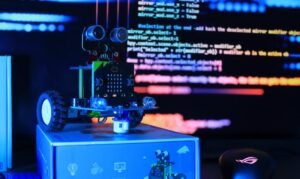Artificial Intelligence with Python Books
Artificial Intelligence (AI) is transforming various industries and fields, and Python has become a popular programming language for AI due to its simplicity and flexibility. If you are interested in learning AI with Python, there are several books available that can help you get started and deepen your understanding. In this article, we will explore some of the best AI books with Python as their primary focus.
Key Takeaways
- AI is a rapidly growing field with Python being a preferred programming language.
- There are numerous books available for learning AI with Python.
- Python AI books cover a wide range of topics, from basic concepts to advanced techniques.
- Choosing the right book depends on your level of expertise and specific interests.
- Practice and hands-on projects are crucial for mastering AI with Python.
If you are new to AI and Python, a great starting point is “Python Artificial Intelligence Projects for Beginners” by Joshua Eckroth. This book provides hands-on experience with AI projects using Python and covers various AI techniques such as machine learning, neural networks, and natural language processing. *The book includes detailed explanations and step-by-step instructions to help readers grasp the concepts effectively.
For intermediate learners, “Python Machine Learning” by Sebastian Raschka and Vahid Mirjalili is an excellent choice. This book delves deep into machine learning algorithms and their implementation in Python. *It also covers advanced topics like deep learning and reinforcement learning.
If you have a strong foundation in Python and want to explore advanced AI concepts, “Artificial Intelligence with Python” by Prateek Joshi is a comprehensive guide. *The book covers various advanced AI techniques, including generative models, deep reinforcement learning, and natural language processing.
Comparing Python AI Books
| Book Title | Author | Level | Topics Covered |
|---|---|---|---|
| Python Artificial Intelligence Projects for Beginners | Joshua Eckroth | Beginner | Machine learning, neural networks, natural language processing |
| Python Machine Learning | Sebastian Raschka and Vahid Mirjalili | Intermediate | Machine learning algorithms, deep learning, reinforcement learning |
| Artificial Intelligence with Python | Prateek Joshi | Advanced | Generative models, deep reinforcement learning, natural language processing |
Practical Applications of AI with Python
- AI-powered chatbots: Python allows developers to create intelligent chatbots that can interact with users and provide relevant information.
- Image recognition: Python libraries like TensorFlow and Keras enable the development of accurate image recognition systems.
- Data analysis and prediction: Python’s data analysis libraries, such as pandas and NumPy, combined with AI techniques, enable insightful data analysis and accurate predictions.
Real-world Examples of AI Applications
| Industry | AI Application |
|---|---|
| Healthcare | Diagnosis assistance based on medical images |
| Finance | Fraud detection and financial risk assessment |
| E-commerce | Product recommendations and personalized shopping experiences |
By exploring AI with Python, you can unlock a world of possibilities and contribute to cutting-edge advancements. Remember to choose a book that matches your skill level and interests, and practice regularly to solidify your knowledge and gain hands-on experience. With the right resources and dedication, you can become proficient in AI with Python and embark on exciting AI projects.

Common Misconceptions
Misconception 1: AI is the same as human intelligence
One common misconception about artificial intelligence (AI) is that it is equivalent to human intelligence. Many people believe that AI can think and reason just like humans do, but this is not the case. AI is based on algorithms and data analysis, whereas human intelligence involves complex cognitive processes and emotions.
- AI is based on algorithms and data analysis, not emotions.
- AI cannot replicate the complexity of human reasoning.
- AI lacks consciousness and self-awareness.
Misconception 2: AI will take over humans and eliminate jobs
Another misconception is that AI will eventually replace humans in various industries and result in job losses. While AI can automate certain tasks and streamline processes, it does not necessarily mean it will entirely replace human workers. AI is designed to complement human capabilities by augmenting productivity and efficiency.
- AI can automate repetitive and mundane tasks, freeing up humans for more complex work.
- AI can enhance decision-making by providing data-driven insights.
- Human skills such as creativity, empathy, and critical thinking are still essential and not easily replaceable by AI.
Misconception 3: AI is perfect and never makes mistakes
Some people believe that AI is infallible and never makes mistakes. However, AI systems are not flawless and can make errors. These errors may stem from biases in training data, limitations in algorithms, or unexpected scenarios. It’s important to acknowledge that AI systems are created by humans and can exhibit biases and limitations.
- AI can be biased due to biases in training data or algorithms.
- AI may struggle when faced with unusual or unprecedented situations.
- It is crucial to continuously monitor and evaluate AI systems to address and correct potential errors.
Misconception 4: AI is only for high-tech companies
Many people associate AI only with large tech companies and believe it is exclusively used by them. However, AI has become more accessible and applicable across various industries and organizations of all sizes. Small businesses and startups can also benefit from AI technologies to improve their operations and customer experiences.
- AI technologies are becoming more accessible and affordable.
- AI can be applied in diverse sectors, including healthcare, finance, education, and manufacturing.
- Small businesses can leverage AI to gain a competitive edge and enhance efficiency.
Misconception 5: AI is a threat to humanity
There is a common misconception that AI poses an existential threat to humanity, fueled by science fiction depictions of rogue AI. While it is crucial to consider ethical implications and address potential risks, AI is developed and controlled by humans. Responsible AI development prioritizes ethical guidelines to ensure AI systems serve human interests and align with societal values.
- Responsible AI development involves ethical considerations and guidelines.
- AI can serve as a valuable tool to tackle complex global challenges.
- Human oversight and regulation are necessary to mitigate risks and ensure AI remains beneficial to society.

Table: Top 5 Bestselling Artificial Intelligence Books
These books have gained immense popularity among AI enthusiasts. They provide comprehensive insights into AI concepts and practical applications.
| Title | Author | Publication Year | Average Rating |
|---|---|---|---|
| Artificial Intelligence: A Modern Approach | Stuart Russell, Peter Norvig | 1995 | 4.5 |
| The Hundred-Page Machine Learning Book | Andriy Burkov | 2019 | 4.6 |
| Deep Learning | Yoshua Bengio, Ian Goodfellow, Aaron Courville | 2016 | 4.7 |
| Predictive Analytics: The Power to Predict | Eric Siegel | 2013 | 4.3 |
| Python Machine Learning | Sebastian Raschka, Vahid Mirjalili | 2015 | 4.2 |
Table: Comparison of AI Frameworks
This table compares various popular frameworks used in building and implementing artificial intelligence projects.
| Framework | Language | Support | Community Size |
|---|---|---|---|
| TensorFlow | Python | Active | 2.7 million |
| PyTorch | Python | Active | 1.1 million |
| Keras | Python | Active | 700,000+ |
| Caffe | C++ | Inactive | 200,000+ |
| MXNet | Multiple | Active | 600,000+ |
Table: Application of AI in Various Industries
This table highlights the impact of AI in different industries, showcasing its widespread use and potential.
| Industry | Applications |
|---|---|
| Healthcare | Medical diagnosis, drug discovery, patient monitoring |
| Finance | Fraud detection, algorithmic trading, risk assessment |
| Transportation | Autonomous vehicles, route optimization, traffic prediction |
| Retail | Personalized recommendations, demand forecasting, inventory management |
| Education | Intelligent tutoring systems, personalized learning, plagiarism detection |
Table: Key AI Programming Languages
Various programming languages are instrumental in AI development and implementation.
| Language | Main Features | Popularity |
|---|---|---|
| Python | Simplicity, extensive libraries, community support | High |
| R | Statistical analysis, data visualization, data mining | Medium |
| Java | Scalability, performance, enterprise-level applications | High |
| Julia | High-performance, mathematical computing | Low |
| C++ | Efficiency, low-level hardware control | Medium |
Table: AI vs. Human Intelligence
This table explores the distinctions between AI and human intelligence, highlighting their respective strengths and limitations.
| Aspect | Artificial Intelligence | Human Intelligence |
|---|---|---|
| Processing Power | Superior for repetitive tasks and complex calculations | Limited by cognitive capacity and physical endurance |
| Creativity | Capable of generating novel solutions | Exhibits innovative thinking and imagination |
| Emotional Intelligence | Devoid of emotions and empathy | Empathy, understanding of emotions and social cues |
| Learning Abilities | Quickly acquires knowledge through data analysis | Adapts, learns, and reasons based on experiences |
| Biological Constraints | Immune to physical and cognitive limitations | Bound by biological and physiological restrictions |
Table: Common AI Algorithms
This table illustrates commonly used algorithms in artificial intelligence, providing an overview of their purposes and applications.
| Algorithm | Purpose | Applications |
|---|---|---|
| Linear Regression | Predicting continuous values | Stock market prediction, housing price estimation |
| Artificial Neural Networks | Pattern recognition, classification | Image recognition, natural language processing |
| Decision Trees | Classification, regression | Customer segmentation, disease diagnosis |
| K-Means Clustering | Data clustering, unsupervised learning | Market segmentation, anomaly detection |
| Reinforcement Learning | Optimal decision-making in dynamic environments | Game-playing agents, robotics control |
Table: Ethical Considerations in AI Development
This table highlights the ethical challenges arising from AI development and its deployment in society.
| Ethical Challenge | Description |
|---|---|
| Privacy and Data Security | Protecting personal data against unauthorized access |
| Algorithmic Bias | Ensuring fairness and minimizing discrimination |
| Autonomous Weapons | Maintaining control and adherence to ethical guidelines |
| Loss of Human Jobs | Addressing unemployment due to automation |
| Accountability and Liability | Establishing responsibility for AI decision-making |
Table: AI and its Impact on Job Roles
This table examines the transformative impact of AI on various job roles, highlighting the potential for job displacement and job creation.
| Job Role | Impact |
|---|---|
| Customer Service Representatives | Potential job displacement due to chatbots and virtual assistants |
| Data Analysts | Increased demand with AI-driven analytics |
| Drivers | Job disruption with self-driving vehicles |
| Software Developers | New opportunities in developing AI applications and algorithms |
| Surgeons | Enhanced surgical procedures through AI-assisted technologies |
Table: AI in Science Fiction vs. Reality
This table compares depictions of AI in science fiction with the current reality of AI.
| Aspect | Science Fiction | Reality |
|---|---|---|
| Human-like Robots | Fully autonomous, human-like robots capable of emotions | Robots with limited functionality, no emotions |
| Superintelligence | AI surpassing human intelligence and taking over the world | Current AI limited to narrow tasks, no general intelligence |
| Time Travel Prediction | AI predicting and preventing future events | AI-based predictive analytics, but limited to trends and probabilities |
| Consciousness | AI developing self-awareness and consciousness | No evidence of AI attaining consciousness |
| Emotionally Bonding with Humans | AI forming deep emotional connections with humans | Current AI lacks emotions and emotional bonding ability |
Conclusion
Artificial Intelligence is a rapidly evolving field with immense potential to revolutionize various industries and impact everyday life. The tables provided in this article demonstrate the diverse aspects of AI, including popular books, frameworks, applications, languages, algorithms, ethical considerations, job roles, and its depiction in science fiction. As AI continues to advance, it is crucial to address the associated ethical challenges and ensure its responsible development and deployment. By exploring the information presented in these tables, readers can gain a deeper understanding of the multifaceted world of AI and its role in shaping the future.
Frequently Asked Questions
1. Are there any recommended books for learning Artificial Intelligence with Python?
Yes, there are several highly recommended books for learning Artificial Intelligence with Python. Some popular titles include “Hands-On Machine Learning with Scikit-Learn, Keras, and TensorFlow” by Aurélien Géron, “Python Machine Learning” by Sebastian Raschka and Vahid Mirjalili, and “Deep Learning with Python” by François Chollet.
2. What topics are covered in these books?
These books cover a wide range of topics related to Artificial Intelligence and Python programming. They typically cover machine learning algorithms, deep learning architectures, natural language processing, data preprocessing, model evaluation, and practical examples and projects using Python libraries like Scikit-Learn, Keras, and TensorFlow.
3. Are these books suitable for beginners?
While some of these books assume a basic understanding of Python programming, they can still be valuable for beginners interested in Artificial Intelligence. The authors often provide clear explanations and step-by-step instructions to help beginners grasp the concepts and apply them in practice.
4. Are there any prerequisites for reading these books?
Some books may recommend having a decent understanding of Python programming, basic statistics, and linear algebra as prerequisites. However, most of them also provide introductory chapters or appendices that cover the necessary background information, making them accessible to readers without prior knowledge in these areas.
5. Can these books be used as reference materials?
Absolutely! These books serve as comprehensive reference materials that cover various aspects of Artificial Intelligence with Python. You can revisit specific chapters or sections whenever you need to brush up on a concept, understand a particular algorithm, or implement a specific technique.
6. Is there hands-on coding involved in these books?
Yes, these books emphasize hands-on learning and often provide code examples and exercises throughout the chapters. Readers are encouraged to write and execute Python code to implement algorithms, train models, and solve real-world problems using Artificial Intelligence techniques.
7. Can these books be used for self-study?
Absolutely! These books are designed to be self-contained resources for learning Artificial Intelligence with Python. They provide clear explanations, code samples, and practical exercises, allowing self-learners to study and practice at their own pace.
8. Are there any online resources or companion websites provided with these books?
Many of these books have companion websites that provide additional resources such as datasets, code repositories, and online forums for readers to ask questions and interact with the authors or fellow readers.
9. Are these books updated regularly to keep up with the evolving field of Artificial Intelligence?
Yes, the authors of these books are committed to keeping them up to date with the latest advancements in the field of Artificial Intelligence. They often release new editions or updates to reflect the evolving algorithms, frameworks, and best practices.
10. Where can I purchase these books?
These books can be purchased online through various platforms such as Amazon, Barnes & Noble, or directly from the publishers’ websites. They are available in both printed and eBook formats.




